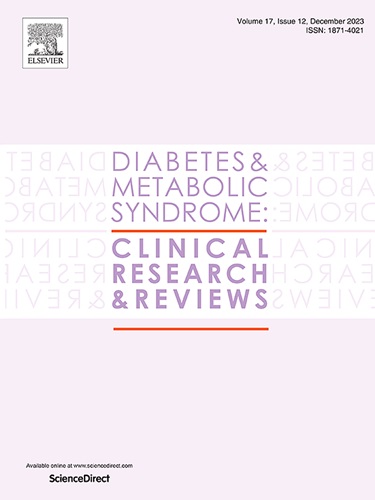糖尿病对细胞连接的影响:病理见解和新出现的治疗靶点。
IF 3.4
Q1 ENDOCRINOLOGY & METABOLISM
Diabetes & Metabolic Syndrome-Clinical Research & Reviews
Pub Date : 2025-08-01
DOI:10.1016/j.dsx.2025.103300
引用次数: 0
摘要
背景:细胞连接在组织的正常功能中起着举足轻重的作用。这些连接的表达或结构的改变与包括糖尿病及其继发性并发症在内的几种病理有关。因此,本文就糖尿病对不同器官和组织间细胞连接的影响进行综述。方法:根据PRISMA指南,使用相关关键词对PubMed和其他相关搜索源进行系统综述。此外,还仔细审查了所有列入全文的参考书目,以找出更多的报告。结果:在最初确定的646篇文章中,323篇被认为是相关的,并被纳入本综述。研究结果表明,高血糖可诱导细胞连接蛋白的过度磷酸化,导致错误定位、下调和细胞内通讯受损。虽然多个连接受到影响,但基于连接蛋白的间隙连接似乎在不同组织中一致受到影响。这突出了它们作为减轻糖尿病及其相关并发症的治疗靶点的潜力。结论:总的来说,这篇综述强调了糖尿病不同组织中受影响的细胞连接类型。此外,结合细胞连接靶向干预与标准血糖控制方案可能提供协同效益,以预防继发性糖尿病并发症。本文章由计算机程序翻译,如有差异,请以英文原文为准。
Impact of diabetes on cellular connections: Pathological insights and emerging therapeutic targets
Background
Cell junctions play a pivotal role in the normal functioning of tissues. The alterations in the expression or structure of these junctions are linked to several pathologies including diabetes mellitus and its secondary complications. Therefore, this review discusses the implications of diabetes mellitus on cell junctions across different organs and tissues.
Methodology
A systematic review of PubMed and other relevant search sources was conducted using relevant keywords in accordance with PRISMA guidelines. In addition, the reference lists of all included full texts were meticulously reviewed to find additional reports.
Results
Among 646 initially identified articles, 323 were found relevant and have been included in this review. The findings of the review suggested that hyperglycemia induces hyperphosphorylation of cell junctional proteins leading to mis-localization, downregulation and impaired intracellular communication. Although multiple junctions are affected, connexin-based gap junctions appear to be consistently affected across various tissues. This highlights their potential as a therapeutic target for mitigating diabetes mellitus and its associated complications.
Conclusions
Overall, this review highlights the types of cell junctions affected in diabetes mellitus across different tissues. Moreover, integration of cell junction-targeted interventions along with standard glycemic control regimens might provide synergistic benefits to prevent secondary diabetic complications.
求助全文
通过发布文献求助,成功后即可免费获取论文全文。
去求助
来源期刊

Diabetes & Metabolic Syndrome-Clinical Research & Reviews
ENDOCRINOLOGY & METABOLISM-
CiteScore
22.90
自引率
2.00%
发文量
248
审稿时长
51 days
期刊介绍:
Diabetes and Metabolic Syndrome: Clinical Research and Reviews is the official journal of DiabetesIndia. It aims to provide a global platform for healthcare professionals, diabetes educators, and other stakeholders to submit their research on diabetes care.
Types of Publications:
Diabetes and Metabolic Syndrome: Clinical Research and Reviews publishes peer-reviewed original articles, reviews, short communications, case reports, letters to the Editor, and expert comments. Reviews and mini-reviews are particularly welcomed for areas within endocrinology undergoing rapid changes.
 求助内容:
求助内容: 应助结果提醒方式:
应助结果提醒方式:


